Accurate sales forecasting is more critical to business success than most realize. Having a predictable pipeline enables more effective decision-making, from headcount planning to strategic investments in technology and beyond. During SaaStr Annual, Eric Huff, VP of Sales Strategy and Programs, and Theresa Stevens, Regional VP of the SMB sales team, shared an “under the hood” look at how Salesforce does its internal forecasting using Salesforce.
While it may sound simple, this is actually one of Salesforce’s most requested sessions in their executive briefing center since running accurate forecasts is so critical to business success, yet it’s not always easy to execute.
The 3 Pillars of a Successful Forecasting Culture
Salesforce has three main pillars for a successful forecasting culture.
- People
- Process
- Data and Tools
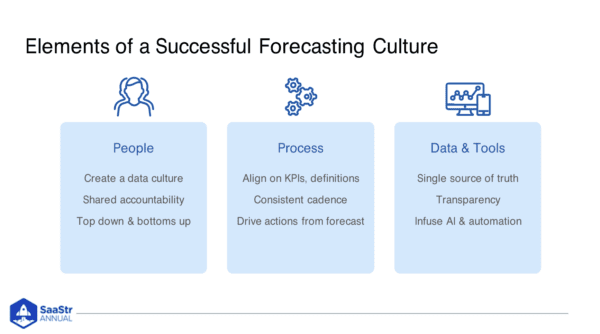
For people, you must have a data-driven culture where every individual, from the C-suite executive to the individual contributor, is held accountable for their sales forecast. The process is all about aligning the process across all departments and looking at the most critical KPIs and definitions. This requires a very thoughtful and consistent cadence in how you look at forecasting so it drives action.
It’s not just about reporting “the news.” It’s looking at forecasts and understanding what actions need to be taken next to move the needle. The third element is data and tools. Every organization needs a single source of truth for forecasting data to avoid swivel-chairing between endless reports and spreadsheets.
Sales is a Team Sport at Salesforce
At Salesforce, sales is a team sport. An AE leads their accounts and is responsible for managing their relationships with the customer. They’re also acting as the quarterback for the overall deal cycle. And every AE knows they can’t be successful just on their own. They need support from pre and post-sales partners.
At the top of the funnel, AE’s rely on business development reps to fill their pipeline and create earlier-stage opportunities. While in active deal cycles, AEs at Salesforce rely on specialist sellers and solution engineers to serve as their product and subject-matter experts. The role of the sales leader then is to come and lean in wherever they’re needed during the sales cycle, and coach the rep through the deal cycle.
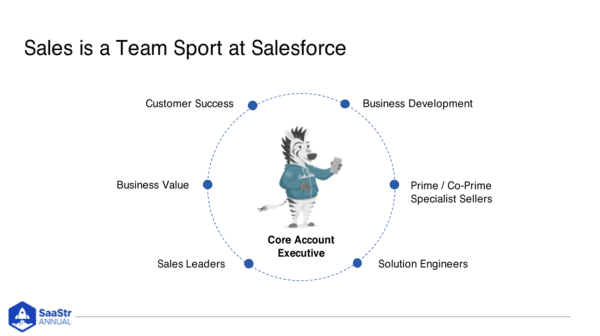
The business value team helps customers understand the justification of spend and practical business cases to achieve ROI. While Customer Success supports the post-sales handoff to ensure smooth implementation and ongoing adoption of the tech they’ve purchased.
Each function is critical in the Salesforce forecasting process, from identifying opportunities to ensuring customers are happy with their purchase.
This team has to follow the golden rule.
If It’s Not In CRM, It Doesn’t Exist
That’s the Golden Rule at Salesforce.
Anytime you have an opportunity or an interaction with a customer, it has to be logged into the system. If it isn’t, it’s like it never happened. This philosophy is embedded into every team and the culture at Salesforce.
Every basic input helps the forecast. Without them, forecasting accurately becomes impossible.
Forecasting accountability is on everyone, from the CRO to a BDR. Everyone has to do their part. An AE and BDR identify, create, and move opportunities through the deal cycle, while sales leaders add their own judgment and roll up the final commit forecast of that territory. Executives like CRO Miguel Milano hold weekly forecast calls 52 weeks a year, where he inspects the sales forecast to see what’s going on with different deals and offer top-down guidance.
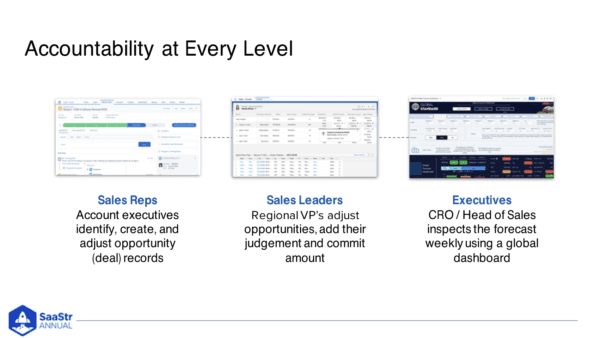
The Exact Forecasting Process at Salesforce
The first step in establishing your forecasting process is aligning and determining what success looks like for your business. Decide what key performance indicators are critical for your company and agree on and define those across the organization.
For Salesforce, they closely monitor pipeline generation, open opportunities, and ACV to determine if they have enough pipeline to hit their targets and if they’re growing at the rate they expect. They also look at annual order value and attrition to asses the general stability of the business. For them, this doesn’t stop at defining KPIs. They also defined stages within the sales cycle.
For Salesforce, a deal doesn’t become part of the pipeline until it reaches stage two. When a deal gets to stage four, they consider it a higher likelihood for a close or later-stage deal.
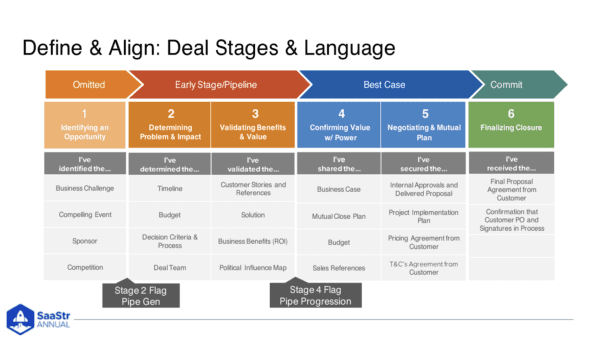
Establish Guardrails for a Clean Pipeline
A clean pipeline is essential for an accurate forecast. Salesforce has a couple of rules for this.
- Opportunity records must have the stage, the dollar amount, and the close date. Leaders also have to input their assessment of the deal and the next action steps for closing
- Everything should be happening centrally in the CRM, not separate tools or spreadsheets and no alternate book of records
- Foster deal collaboration (either within CRM records or in productivity tool of choice)
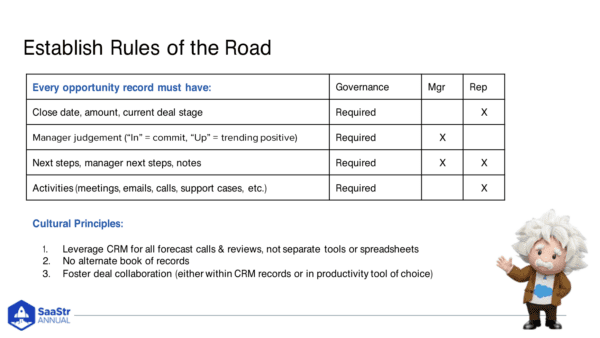
Drive a Weekly Cadence Around Sales Forecasting
Every role plays a part in pipeline management. At Salesforce, they have a sales forecasting meeting every single day of the week.
On Mondays, the CRO and CEO meet and review the forecast, looking at week-over-week changes, big deals, and outlook. At the same time, AE’s are expected to go in and update opportunities. There’s true top-down, bottoms-up accountability across the forecast. As the week progresses, different levels of sales leadership will review forecasts and inputs and provide feedback to the account teams.
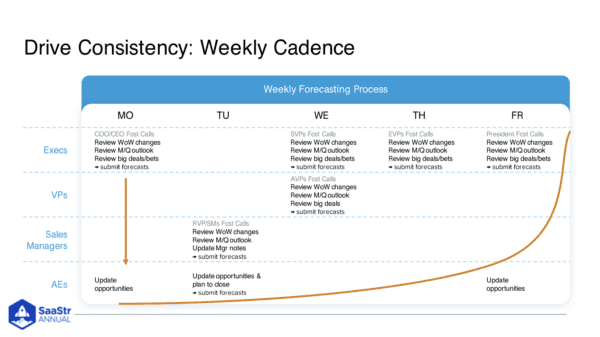
Don’t just drive a weekly cadence. The weekly cadence feeds into the greater annual cadence review. Weekly cadences give a better grasp on the business and more accurately forecast things like QBRs and All Hands calls.
The most important takeaway is that Salesforce has developed a muscle around inspection in terms of business processes, so at any point in time, they can identify any gaps and proactively address any concerns.
With the different team member roles in place, cadences, accountability, and definitions, Salesforce teams can report on their forecast in real-time. They do this through using their own CRM reporting and CRM native analytics tool. Teams are constantly required to update, manage, and inspect their forecasts, pipeline, and opportunities, and update those in real-time, as needed.
Key Takeaways From Salesforce Forecasting
- Establish a data-driven culture. Ensure that every sales team member is held accountable to their forecast and can speak a common pipeline language.
- Aim to create a consistent forecasting process. Make it a machine.
- Create one single source of truth inside your CRM for forecasting so that every team member knows exactly what data to use to make the best, most informed decisions possible on their forecast.
The post How Salesforce Runs Its Internal Forecasting Process with Salesforce’s VP Sales Strategy & Programs and RVP SMB Sales appeared first on SaaStr.
via https://www.aiupnow.com
Amelia Ibarra, Khareem Sudlow
